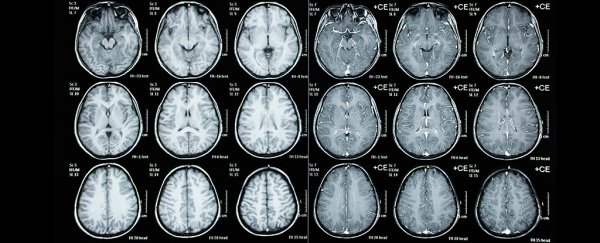Early results from a landmark research program designed to observe the brain development and health of American children have just been released, revealing a first glimpse at a dataset both invaluable and, in many ways, disquieting.
The Adolescent Brain Cognitive Development (ABCD) Study is the largest long-term study of its kind in the United States, involving almost 11,700 healthy children aged between nine and ten who are being studied at over 20 research sites across the country.
At the outset of the ABCD Study, this huge, demographically diverse cohort of children had their brains scanned by high-resolution structural magnetic resonance imaging ( MRI) machines.
This was to provide a baseline measurement of their developing brains, which will be rescanned at two-year intervals for the duration of the 10-year longitudinal study – helping scientists to understand how the children's brain development might be linked to a huge range of factors, from sleep levels to sport, substance use, time spent playing video games, academic results, and much more.
Yet even before researchers can start to fathom whatever links and associations might lie ahead for the ABCD cohort, those baseline measurements of their brains, taken between 2016 and 2018, are already providing new insights about their brain health – and by extension, that of American children as a whole, given the cohort was selected to reflect the general sociodemographic diversity of the US population.
In a new analysis of the results led by first author and neuroradiologist Yi Li from UC San Francisco (UCSF), researchers used the dataset to measure rates of what are called 'incidental findings' (IFs).
In this context, IFs are unexpected brain abnormalities discovered during the imaging process, ranging from healthy and benign anatomical variants in brain structures to serious anomalies such as cysts and tumors that may require urgent medical intervention.
Within the ABCD cohort, approximately 3.9 percent of the scans – representing almost one in every 25 children – showed IFs for which non-urgent or urgent clinical referral was recommended, the researchers found, whereas approximately 21 percent of the children overall had some kind of IF.
Discovering clinically significant brain abnormalities in almost 4 percent of a sample taken to be representative of the general US population sounds alarming, but it's important to note that only about one in 500 children demonstrated abnormalities serious enough to be deemed a potentially life-threatening condition, for which immediate clinical referral was recommended.
Going forward, the ABCD Study will provide an unprecedented opportunity to continually monitor the brain and physical health and development of these children, as well as track the IFs so far discovered.
"The study is unique in its magnitude, participant diversity, and standardization of protocols," the authors write. "To our knowledge, an observational study of this size and scope has never been performed in this field."
Perhaps most crucially, the cohort is now entering its teenage years, a phase in their lives in which their brain development will undergo significant and sometimes serious changes, with many adolescents potentially revealing mental health disorders as they age.
"Brain changes during this period are suspected to influence risk for disorders such as schizophrenia, depression, attention-deficit/hyperactivity disorder, and addiction," explains senior author and UCSF neuroradiologist Leo Sugrue.
"To date, our understanding of those relationships has been limited by a lack of high-quality longitudinal data, a gap that the ABCD Study aims to fill."
While many of the findings lie years into the future, for some of these young people and their families, their involvement with this pioneering research has already paid off in ways they could not have imagined.
The case of one boy in particular – whose brain scans revealed a brain tumor that was ultimately successfully removed – foreshadows just how important this science is.
As his mother later said: "I'm forever grateful because his participation in this study probably saved his life."
The findings are reported in JAMA Neurology.
